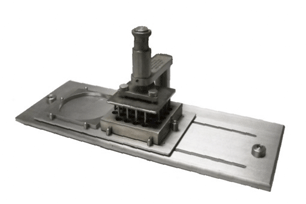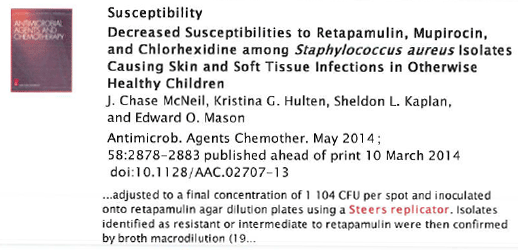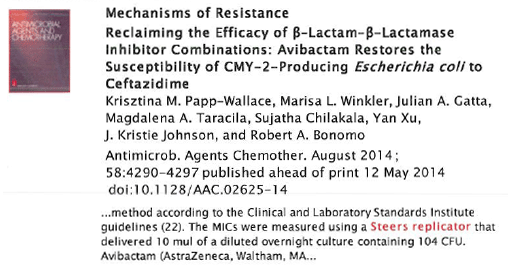Multiple Inoculator (Steers Replicator)

This Inoculator, designated also as the Pepper Laboratory Inocula Replicator, can be used in many different situations especially for the routine bacteriophage typing of staphylococci and routine testing of bacterial susceptibility to chemotherapeutic inocula by a single manipulation of the instrument.
Bacteriophage typing or the routine in virto testing of the susceptibility of bacterial isolates to chemotherapeutic agents incorporated in an agar culture medium has necessitated either the separate pipetting or streaking of each inoculum on as many plates of inoculations pipetted or streaked may reach sizable proportions in a laboratory where many tests are done simultaneously. The Multiple Inoculator is a labor savings device which permits more than 50 replicate plating of each inoculum with each filling of the reservoirs.
Description of the Instrument
The apparatus is made of aluminum and consists of:
- A sliding positing plate holder for the seed plant on the right, containing 32 specifically located inocula reservoirs, and the plate on the left containing the medium to be inoculated
- An aluminum head possessing 32 specifically spaced aluminum inoculating rods corresponding in position to the location of the inocula reservoirs in the seed plate
- A three point attachment for the aluminum inoculating head to a suspending and actuation mechanism consisting of a triangular plate, plunger, cylinder, and two springs
The plunger is held in an elevated position by the limited extension of a spring located within the cylinder. The free attachment of the head is arranged so that initial contact of the rods with the surface of the medium stops the downward motion of the rods. Only the weight of the inoculating head and rods presses against the medium. Thus dishes with varying depths of medium may be used, so that maximum depression of the plunger may occur with out breaking the surface of the agar.
Furthermore, the depth of the plunger thrust can be adjusted from 4 to 12 mm above the culture dish bottom by means of a pair of circular lock rings located on the upper end of the plunger. This is an additional safeguard against breaking the surface of the culture medium. The upward motion of the plunger is cushioned by a spring to avoid spattering of inocula.
Camlike, adjustable stops located at the ends of the base of the apparatus permit precise positioning of the seed plate and the inocula reservoirs with respect to the inoculating rods of the head.
When necessary the complete apparatus may be sterilized with dry heat, however, prior to use the clean inoculating head and seed plate may be sterilized either by dry heat or by autoclaving at 121.5 c for 20 minutes.
Directions for Use of the Multiple Inoculator (Steers Replicator)
Routine Bacteriophage Typing of Staphylococci: Pipet a maximum of 0.6 ml of each specific bateriophage, at its critical test dose (C.T.D), into the individual wells of the sterile seed plate. Place the loaded seed plate in the right hand position of the slide plate of the apparatus. The single larger positioning stop will match in a single position with the corresponding groove on the side of the seed plate.
Move the slide plate to the extreme left thus precisely positioning the seed plate beneath the inoculating head rods. Place a dried trypticase soy agar (supplemented with 500 Mg CaCl2 per ml) plate in the left hand position on the slide plate.
Pressure on the piston followed by controlled release results in the dipping of the inoculating rods into and out of reservoirs of the seed plate. The slide plate is moved to the extreme right thus locating the trypticase soy agar plate beneath the inoculating rods and their individual specific bacteriophage inocula.
Gently depress the plunger until the inoculating rods rest on the surface of the medium. Controlled release of the pressure results in the in inoculating rods rising free of the surface of the medium Precisely spaced drops (approx. 8 ul per drop) will be evident upon the surface of the medium.
Following complete drying of the bacteriophage inocula the plates are flooded with 2 ml of a staphylococcus broth culture in such a manner that the entire surface of the plate is inoculated. The excess culture is pipetted off. The process is repeated for as many cultures as require typing.
The plates are incubated at 30 C for 18-24 hours. The cultures are examined for evedence of lysis by bacteriophage. Degree of lysis may be recorded as follows: Confluent lysis = 3+: 50 or more plaques = 2+: 20 or more plaques = 1+; less than 20 plaques = +
Routing Testing of Bacterial Susceptibility to Chemotherapeutic Drugs: The procedure for the routine testing of bacterial susceptibility to chemotherapeutic drugs is similar to the for bacteriophage typing, except that inocula size and drug containing media will vary with the laboratory and / or problem.
A maximum of 0.6 ml of each clinical bacterial isolate is placed in the reservoirs of the seed plate which is then placed in the right hand position on the slide plate. The Plate with the drug containing medium is located on the left hand side of the slide plat. The inoculation of the plates with the clinical isolates is performed as describe for the inoculation of the plate medium with bacteriophage.
Following drying of the bacterial inocula the plates are inverted and incubated at 37 C for 24 hours. No growth indicates sensitivity to the concentration of the drug used. One or more colonies is interpreted as resistance to the concentration of the drug. A plate containing medium without drug is run as inoculum visibility control.
Link: A Steers Replicator is used to apply inocula onto an agar plate
Video: How to Use of the Steers Replicator
Click on the following link to download a copy of the Steers Replicator Directions.
Steers Replicator Found in ASM Journal


Acknowledgement:
These directions have been prepared with the kind assistance of Dr. Edward Steers of the University of Pennsylvania.
Reference literature:
(1) E.S. Anderson and R.E. O. Williams, "Bacteriophage Typing of Enteric Pathogens and Staphylococci and its use in Epideiology" Journal of Clinical Pathology, Vol. 9, p. 94 (1956)
(2) E. Steers, E.L. Foltz, and B.S. Graves. "An Inocula Replication Apparatus for routine Testing of Bacterial Susceptibility to Antibiotics", Antibiotics and Chemotherapy, Vol. 9, No. 5, p. 307-311 (May 1950).
Manufactured by:

